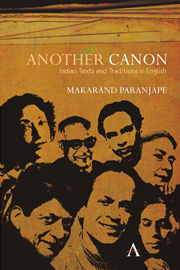Book contents
- Frontmatter
- Contents
- Preface
- 1 Introduction
- 2 Conversations in Bloomsbury
- 3 Comrade Kirillov
- 4 ‘A Horse and Two Goats’
- 5 The Tale of an Indian Education
- 6 ‘Clip Joint’
- 7 Cultural and Political Allegory in Rich Like Us
- 8 Towards Redefining Boundaries
- 9 The Golden Gate and the Quest for Self-Realization
- 10 Journey to Ithaca An Epistle on the Fiction of the 1980s and 1990s
- 11 Cuckold in Indian English Fiction
- 12 Stephanians and Others
- Works Cited
- Index
5 - The Tale of an Indian Education
The Silver Pilgrimage
Published online by Cambridge University Press: 05 March 2012
- Frontmatter
- Contents
- Preface
- 1 Introduction
- 2 Conversations in Bloomsbury
- 3 Comrade Kirillov
- 4 ‘A Horse and Two Goats’
- 5 The Tale of an Indian Education
- 6 ‘Clip Joint’
- 7 Cultural and Political Allegory in Rich Like Us
- 8 Towards Redefining Boundaries
- 9 The Golden Gate and the Quest for Self-Realization
- 10 Journey to Ithaca An Epistle on the Fiction of the 1980s and 1990s
- 11 Cuckold in Indian English Fiction
- 12 Stephanians and Others
- Works Cited
- Index
Summary
First published in 1961, M Anantanarayanan's The Silver Pilgrimage, though not a well-known novel, does have a selected readership. Its author, who was born in 1907 and who died a few years back, was a judge in the Madras High Court, a connoisseur of music, and a recognized figure in the intellectual circles of Madras. He was not a writer by profession and The Silver Pilgrimage is his only novel. His father was the distinguished English and Tamil writer, A Madhavaiah, the author of books like Thillai Govindan (1908) and Clarinda (1915). The Silver Pilgrimage itself is a unique novel. Its narrative technique is a mixture of fable and fantasy, somewhat reminiscent of another neglected novelist, Sudhin Ghose. It differs from Ghose's works in that it is set in the mythical past of medieval India, though the narrative voice is thoroughly modern. The overall effect, as Harvey Breit points out in his preface, is magical:
Such is the exotic power of this small novel, The Silver Pilgrimage. One enters the supernatural world in the most natural way, embarking on a pilgrimage as a twentieth-century western man to return partially clothed in the raiments of an ancient India. Call it a novel, a tapestry, a pageant, a tour de force… (5). The Silver Pilgrimage is both comic revelatory, and something beyond. It has its own luminosity; it is magic (7).
- Type
- Chapter
- Information
- Another CanonIndian Texts and Traditions in English, pp. 51 - 60Publisher: Anthem PressPrint publication year: 2009



